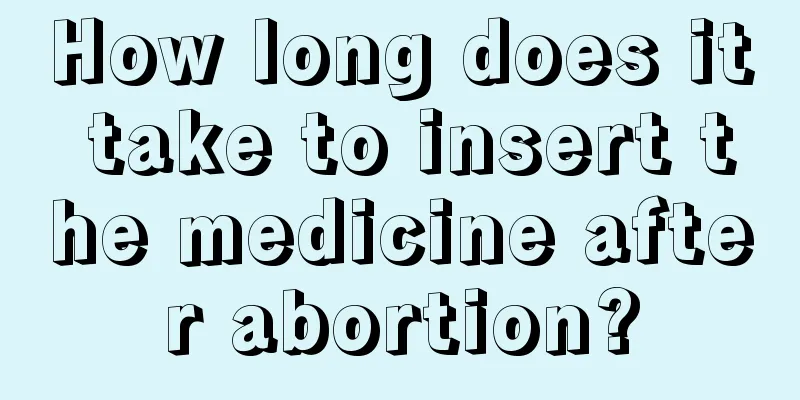A small amount of blood two days before menstruation

|
Many women experience some bleeding one or two days before their period. In fact, there is a small amount of blood two days before menstruation, which is caused by irregular menstruation. This phenomenon is also called menstrual blood staining. In fact, if the situation is not very serious, you don’t need to take it too seriously. If the bleeding is severe, it is best to know what causes the irregular menstruation. Pathological menstrual disorders must be treated promptly. 1. Abnormal emotions cause menstrual disorders Emotional abnormalities, such as long-term mental depression, mental tension, or severe mental stimulation and psychological trauma, can lead to menstrual disorders or dysmenorrhea or amenorrhea. This is because menstruation is caused by the hormones secreted by the ovaries acting on the endometrium. The hormones secreted by the ovaries are controlled by the hormones released by the pituitary gland and hypothalamus. Therefore, any abnormality in the function of the ovaries, pituitary gland, or hypothalamus will affect menstruation. 2. Cold stimulation causes oligomenorrhea or even amenorrhea When women are exposed to cold during menstruation, the blood vessels in the pelvis will contract excessively, which can cause oligomenorrhea or even amenorrhea. Therefore, women should pay attention to preventing cold and avoiding dampness during menstruation in their daily life. 3. Dieting causes irregular menstruation A girl’s body fat must account for at least 17% of her body weight before she can have her first menstruation, and her body fat must reach at least 22% of her body weight to maintain a normal menstrual cycle. Excessive dieting will cause a large amount of fat and protein in the body to be consumed due to insufficient energy intake, resulting in estrogen synthesis disorders and obvious estrogen deficiency, affecting menstruation, or even causing scanty menstruation or amenorrhea. Therefore, women who pursue a slim figure must not diet blindly. 4. Smoking and drinking cause menstrual disorders Certain ingredients and alcohol in cigarettes can interfere with physiological processes related to menstruation and cause menstrual disorders. Among women who smoke and drink excessively, 25% to 32% go to the hospital for treatment due to menstrual disorders. Among women who smoke more than one pack of cigarettes a day or drink more than 100 ml of strong liquor, the incidence of menstrual disorders is three times that of women who do not smoke or drink. Therefore, women should not smoke and drink less alcohol. Clinical manifestations There are several situations in which the disorder of menstrual cycle or bleeding volume is manifested: 1. Irregular uterine bleeding This is a clinical symptom, including: heavy menstrual bleeding or prolonged menstrual bleeding. It is common in diseases such as uterine fibroids, endometrial polyps, endometriosis or dysfunctional uterine bleeding. 2. Dysfunctional uterine bleeding It refers to abnormal uterine bleeding caused by endocrine regulation system disorders without obvious organic lesions in the internal and external genitalia. It is the most common type of menstrual disorder and is common in adolescence and menopause. It is divided into two categories: ovulatory and anovulatory. About 85% of cases are anovulatory functional uterine bleeding. 3. Amenorrhea It is a common symptom in gynecological diseases and can be caused by a variety of different reasons. Amenorrhea is usually divided into primary and secondary types. Anyone who has not had menstruation by the age of 18 is called primary amenorrhea; those who have no menstruation for more than 6 months at any time after menarche and before normal menopause (except pregnancy or lactation) are called secondary amenorrhea. 4. Menopause Menopause means the cessation of menstruation, which refers to the cessation of menstruation for more than 12 months. However, there are often changes in menstrual cycle and menstrual volume during perimenopause. It manifests as a shortened menstrual cycle, mainly a shortened follicular phase, anovulation and increased menstrual flow. |
<<: Do you have diarrhea before your period?
>>: What's wrong with a sudden heavy menstruation?
Recommend
eMarketer: Facebook ad revenue doubled to $3.8 billion in 2011
eMarketer expects Facebook's revenue to grow ...
What is the matter with my aunt's black period?
Women will experience bleeding during their menst...
Effects of insomnia in late pregnancy on the fetus
Most pregnant mothers are immersed in happiness a...
PathFactory: 2018 Media Buyer Survey Report
PathFactory and HeinzMarket released their latest...
How to do Fallopian tube management therapy
Fallopian tube management therapy is mostly used ...
What to do if there is blood in the anus
There are many common anal diseases. When treatin...
What are the common tools for barbecue? How to marinate barbecued pomfret?
Barbecue is to roast food (mostly meat, seafood, ...
Dull abdominal pain during intercourse
Many people know that they should not have sex du...
Fitness left and right breasts are different in size
We often see some fitness enthusiasts who like to...
Eczema during pregnancy and having a boy
After pregnancy, the diet of many women also chan...
What are the effects of sex during menstruation?
When both parties need to have sex, sometimes the...
2D B-ultrasound boy gender map
Two-dimensional color ultrasound is a necessary t...
What happens if you drink beer during menstruation?
During menstruation, women need to pay special at...









